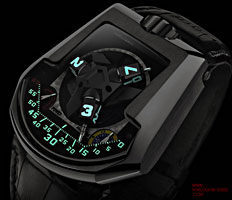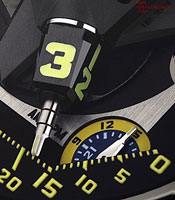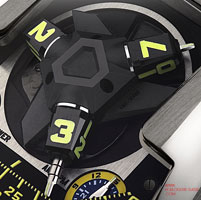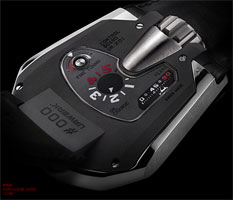

urwerk
Les nouveautés 2007 des montres Urwerk
UR 103.08 TiAlN
Pour la toute première fois, URWERK présente son modèle phare, la 103, habillé d’acier. Avec ce nouveau modèle, URWERK s’appuie sur les derniers développements de la physique des métaux pour marier art horloger et haute technologie. La 103 se pare ainsi du boîtier le plus dur qu’ait connu le monde horloger à ce jour.
L’ingrédient secret qui rend l’acier de la 103 si particulier est le TiAlN. Sous cette abréviation des plus synthétiques se cache un composé mêlant titane, aluminium et nitride. Une épaisseur de TiAlN - 4 microns - a pour effet de démultiplier la résistance du métal qu’il recouvre, le rendant quasi invulnérable aux chocs, à l’oxydation et aux acides.
« Le TiAlN est un matériau utilisé comme couche protectrice pour différents outils afin de renforcer leur résistance aux attaques mécaniques ou chimiques.
La dureté du TiAlN se situe souvent entre 30 et 40 GPa. En comparaison, la dureté du diamant artificiel est de 20-25GPa » nous explique le Dr Ayat Karimi de l’Institut de physique de la matière complexe, EPFL, Lausanne.
La nouvelle 103.08 en acier traité est donc le dernier joyau sur la couronne de la collection 103. Plus légère que ces consoeurs, elle est d’une résistance exceptionnelle.
La preuve en chiffres: (vickers – indice de dureté)
Or: 380 Vickers
Acier: 600 Vickers
TiAlN: 3500 Vickers
Saphir: 4000 Vickers
Un intérêt esthétique certain peut être ajouté aux grandes qualités du TiAlN. Sa couleur dépendant de l’équilibre entre Titane et Aluminium se classe entre le bronze en fusion et les nuances chocolatées.
Boîtier: disponible en acier Dimensions: 50mm x 36mm x 13.5mm
Mouvement: Calibre 3.03 à remontage manuel ; 21,600bph/3Hz ; 43 heures de réserve de marche Triple platines en ARCAP P40 noir
Indication de l’heure sur satellites mus par des « Croix de Genève » Control Board: Titane, indicateur de réserve de marche, cadran de réglage 15 minutes et secondes, vis d’ajustement de l’heure
For the very first time URWERK presents its iconic 103 with a steel case and not just any steel but an incredibly hard TiAlN-coated steel. With this new model, URWERK blurs the frontier between horological art and cutting-edge technology.
The coat of the steel 103.08 is the hardest yet known in the world of haute horlogerie. TiAlN - Titanium Aluminum Nitride - treatment is well-known in industry for its exceptional properties.
A TiAlN coating less than 4 microns thick has the effect of multiplying the resistance of the underlying metal to scratches, shocks, oxidation and even acids.
"TiAlN is a hard material which can be used as protective coating to enhance the lifetime of a variety of work pieces against mechanical or chemical attacks. The hardness of TiAlN is often between 30 and 40 GPa. In comparison, the hardness of DLC (diamond like carbon) is 20-25 GPa”. Dr Ayat Karimi, Institute of Complex Matter Physics, EPFL, Lausanne.
The 103.08 in TiAlN coated steel is the new jewel in the crown of URWERK's 103 collection.
The 103.08 is lighter than its gold and platinum stable mates, yet much harder.
The proof is in the numbers:
Gold : 380 Vickers
Steel : 600 Vickers
TiAlN coat : 3500 Vickers
Sapphire: 4000 Vickers
Attractive aesthetics can be added to TiAlN's technical superiority. Its colour is dependant on the Titanium/Aluminium ratio and can range from melting bronze to stormy black.
Case: available in steel Dimensions: 50mm x 36mm x 13.5mm (including lugs)
Movement: Caliber 3.03, manual wind, 43-hour power reserve, 21,600bph/3Hz. Unique triple base plate in ARCAP P40 black PVD coated. Hour satellites in aluminium, orbital cross in grade 2 titanium. Control Board: Grade 5 titanium, power reserve indicator, 15 minute and seconds dials for precise Time setting, user adjustable fine-tuning screw.
UR 201
La nouvelle 201 est le fruit de 3 longues années de recherche et développement: le design et la conception de ce nouveau modèle ont requis à eux seuls près d’une année de travail ; ont suivi une année d’usinage et de test ; puis une année pour la mise au point du prototype et test mécanique avant sa mise en production finale.
Sur la 201, le temps se lit sur les 3 plots pivotant des heures. Chacun d’eux effectuera trois rotations successives en douze heures dévoilant ainsi chacune de ses quatre faces (1 – 4 - 7- 10 ; 2 – 5 – 8 - 11 et 3 - 6- 9 -12). Ces plots pivotants sont traversés par une aiguille des minutes télescopique. Celle-ci trace sa course en suivant à la ligne les trois segments des minutes : 0- 14 ; 15-44 ; 45-60. En extension, cette aiguille permet une lecture du temps confortable, rétractée elle assure la rotation de la complication satellite central.
Le carrousel– modèle breveté – centre névralgique de la 201 est à la base de la rotation des plots des heures mais aussi de toutes les manœuvres effectuées par les trois aiguilles télescopiques. Le carrousel est d’une technicité telle qu’il requière un usinage au micron près. Après usinage, le carrousel – plots des heures inclus – est ajusté manuellement. Il est ensuite diamanté puis satiné et lustré au poil de cachemire. Enfin, il reçoit un traitement de surface PE-CVD « blacktop » qui lui donnera sa couleur finale et durcira sa surface, diminuant ainsi son coefficient de friction. Le dos du carrousel est lui satiné. L’arrête des plots des heures est diamanté conférant à la pièce des arrêtes aux reflets miroir. Les indications des heures et minutes sont traitées au SuperLuminova, matière luminescente.
Les transporteurs sont les éléments permettant à chacune des aiguilles de parfaitement conformer sa longueur aux 3 segments horizontaux de l’indication des minutes. Une des extrémités du transporteur suit la came – élément qui délimite le chemin à parcourir par l’aiguille – dont la forme a été calculée à partir de 380 points de référence. L’autre extrémité du transporteur contrôle l’allongement de l’aiguille. Chaque transporteur présente une épaisseur de 0.895mm, il est couvert d’un traitement de lubrification MOVIC d’une épaisseur de 0.005mm, soit une épaisseur totale de 0.900mm. Sachant que la hauteur du carrousel est de 0.905mm, la marge d’erreur dans la conception du système est inférieure à 0.005mm. Le recours au traitement MOVIC est une des grandes innovations choisies par URWERK, permettant à la 201 de fonctionner pratiquement sans huile.
Les 3 aiguilles télescopiques des minutes mesurent 4.8mm en pleine extension et permettent une lecture de l’heure aisée et agréable. Rétractées, elles ne mesurent plus que 1.8mm. A l’intérieur de chacune des aiguilles des minutes télescopiques se cache un fin ressort. Dans la pratique, plus celui-ci est fin plus son élasticité est uniforme. Lors du développement de l’Opus V, URWERK avait déjà repoussé les limites en développant un ressort de moins de 100microns – la taille d’un cheveu humain –. Avec la 201, URWERK abaisse encore cette mensuration à 70 microns. (0.07mm).
L’indicateur “oil change” Cet indicateur informe le propriétaire de la 201 de la nécessité d’un service. L’indicateur vire alors du blanc au rouge. Ingénieusement, l’indicateur « oil change » tire son énergie du remontage de la couronne et non du spiral, évitant ainsi tout effet indésirable sur la précision de la montre ou sa réserve de marche.
Abraham Louis Breguet fut l’un des premiers à offrir cette option aux porteurs de ses chronomètres, les invitant ainsi à ajuster précisément la marche de ces montres de poche. URWERK est le premier à intégrer cette option sur une montre-bracelet. Le propriétaire de la 201 peut ainsi ralentir ou accélérer la marche de sa montre de plus ou moins 30sec par jour afin que celle-ci s’adapte à son rythme de vie.
L’odomètre est une indication totalement inédite et originale sur une montre. Inspiré par les jauges présentes sur les voitures de sport, le « 100 ans et plus » décompte le nombre d’année de fonctionnement du mouvement. Il tire son énergie directement du remontage de la couronne – comme le « oil change » - et n’altère ainsi aucunement la marche de la montre. Cette indication linéaire progresse par étape de six ans pour aller au-delà de 118ans.
The new 201 is the result of three long years of research and development by a five man team at URWERK: 12 months in conception and design, 12 months of machining and testing parts, and 12 months of prototyping and testing mechanisms before final production.
Time on the 201 is displayed using telescopic minute hands operating through the middle of three orbiting and revolving hour satellites. The telescopic minute hands precisely adjust their length to follow the three vectors marking the minutes: 0 -14, 15 - 44, 45 - 60. Extended, they enable the 201 to display the time across a large easy-to-read, dial. Retracted, they allow for a very wearable and comfortably sized case; thus providing the wearer with the best of both worlds!
The patented Carousel is the critical component of the revolving satellite complication. It is responsible for not only the rotation of the hour satellites but also the integral telescopic minute hands. This rotating central hub is an extremely complex part to manufacture due to the extreme precision and tight tolerances necessary. Many of the carousel's intricacies have to be machined and finished to tolerances of 1/1000mm. After the Carousel and satellites are milled, they are micro-sandblasted, carefully finished with fine cashmere brush, treated with a sophisticated PE-CVD treatment called 'Blaktop' which hardens, colours and lowers the coefficient of friction. The back of the Carousel is satiné, a process which leaves a distinctive light matt finish without removing material. The 90° edges of the satellites are beveled using a diamanté process resulting in perfect mirror finish angles. There has been no detail spared in maximising both efficiency and readability of the hour satellites. Rather than being set perfectly perpendicular to the horizontal, they are slightly inclined at 85 degrees so that the wearer does not have to tilt the wrist to easily read the time. While technically it may have been easier to have the satellites rotate to the next hour in one step, URWERK have designed the complication so that they rotate over three stages ensuring a more constant use of power.
The Transporters - one for each minute hand- allow the telescoping hands to precisely adjust its length to follow the vector of the minute marker. One end of the transporter follows a cam simulating the path of the three minute indication vectors, while the other controls the length of the minute hand. The cam's shape was designed by plotting 380 points of reference to ensure precision in the length of the telescoping minute hands. The Transporter measures 0.895mm (thickness) plus the lubricating surface treatment is 0.005mm, thus making the total thickness of the transporter 0.900mm. The dimension of the place in carousel where the transporters work is 0.905mm. A tolerance of just 0.005mm!
These transporters - hidden under the wings between the satellite- undergo a special MOVIC surface lubrication treatment so that lubricating oils are not necessary. MOVIC is just one of many treatments and/or process that URWERK developed for use in the 201 resulting in practically no oil being necessary for the lubrication of the entire revolving satellite complication!
The telescopic minute hands, when extended to their maximum length of 4.8mm enable the 201 to display the time on a large, easy-to-read dial. The minutes are shown over 3 straight line segments: each 15minute side has a length of 8.3mm while the central 30 minute segment is 16.6mm. When they are not passing across the minutes, the hands retract to their minimum length of 1.8mm allowing for a very wearable and comfortably sized case. Inside each telescopic minute hand is a minuscule spring. The longer a spring is the more uniform its elasticity. As the overall length and diameter of the space for the spring is fixed, the only way to make it longer is to make the filament a finer diameter. URWERK had already pushed the boundaries of the lower limits of the diameter of springs down to 100 microns - the size of a human hair - with the revolutionary Opus V. With the 201, URWERK brings the size down even further to an incredible 70 microns (0.07mm). This technological advance has led to a considerable increase in power and efficiency.
The Oil Change Indicator The 'Oil Change' indicator informs the owner that a service is due after three years of operation when the dial changes from white to red. Powered directly from the winding of the crown, this indicator has no detrimental effect on either the timekeeping precision of the movement or the power reserve.
While Abraham-Louis Breguet was one of the first to provide a facility allowing his clients to adjust the fine regulation of his pocket watches, URWERK were the first to incorporate this extremely useful function into a wristwatch. The fine tuning screw allows the user to easily and precisely regulate the timing of the watch to tailor it to their specific life style.
The 100 Year Plus indication is a completely new and original indication in a wristwatch. Inspired by the odometer of a car, the 100 Year Plus indicator keeps track of how many years the movement has been in operation. Powered directly from the winding of the crown (as is the Oil Change Indicator), this linear gauge has no detrimental effect on either the timekeeping precision of the movement or the power reserve. The linear indicator advances every six years up until a maximum of 118 years!




